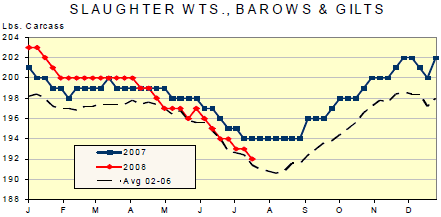



CME: Livestock and Broiler Products
US - CME's Daily Livestock Report for 4 August 2008.
A quick perusal of average slaughter weight data would make one question the economic sensibilities of livestock and broiler producers given the much higher input costs they have faced since the fall of 2006.
| E-Livestock Volume | 8/4/08 | 8/1/08 | 7/29/08 |
|---|---|---|---|
| LE (E-Live Cattle): | 13,282 | 16,239 | 12,596 |
| GF (E-Feeder Cattle): | 1,051 | 2,377** | 800 |
| HE (E-Lean Hogs): | 11,549 | 19,740 | 11,330 |
| **Denotes a new record for Globex volume | |||
The quite correct economic logic is that higher input costs and feed conversion rates that fall as body weights increase should lead producers to sell animals at lighter weights. That end-point could reflect a shorter feeding period or altered diets that result in slower gains over normal feeding periods. But the data show that, in fact, all three species have seen new all-time record highs for weekly slaughter weights in the past year — last October for fed cattle and broilers and in January for hogs. Why this apparent non-optimal behavior?
First, market weight is a key determinant of production efficiency for both producers and packers. Each of these enterprises denominate their major fixed input (ie. facilities) in head — X-thousand head feedyard, Y-thousand head hog finishing barn, Z-thousand head broiler barn, A-thousand head per day packing plant — and denominate their sales in pounds. That difference in and of itself creates a huge incentive to increase pounds per head and over time, all three species have steadily increased the end-weight of their animals.
Second, higher feed costs create some conflicting incentives, especially in the case of fed cattle. While it is true that higher feed costs should push end-weights down, those same higher costs also drive placement weights upward by creating an incentive to add more weight using grass or other forages before the animals are placed in feedlots. Since the “finishing” process is generally denominated in days, higher placement weights plus a relatively fixed number of days on feed lead to higher finished weights. The higher weights that we saw in March and April of this year relative to history and to last year are most likely the result of higher placement weights last fall. The super-seasonal increase in weights last fall was driven by decisions that cattle feeders frequently make when faced with disappointing prices: Feed them a bit longer and hope for a price rally. The extra gain means that seldom works but it hardly ever deters either the thinking or the resulting action.
Third, there are product mix decisions hidden in some of the data — especially that of broilers. The broiler business is really two businesses, one that produces smaller birds generally for parts that go to restaurants selling fried chicken, and another for larger birds that are boned-out to provide boneless breast meat. The large-bird segment has grown relative to the small-bird segment over the past few years and provided the major push for higher broiler weights.
Fourth, it takes time to make weight adjustments —especially for the pork industry that frequently operates very near the level of slaughter capacity. The surge of hog slaughter in March and April of this year was driven by producers trying to market hogs earlier and lighter. The effort had minimal impact for several weeks simply because few “extra” hogs could be slaughtered when plants were already near capacity. But the effort finally drove weights below year-earlier levels in late April and the year-over-year decline has been steady in the 1 to 2 pound range since then. But do not expect much larger declines. The pricing structure for hogs imposes large discounts on light hogs. The feed efficiency gains of eliminating heavy hogs can be wiped out easily if a few “too-light” hogs are added to each load.











